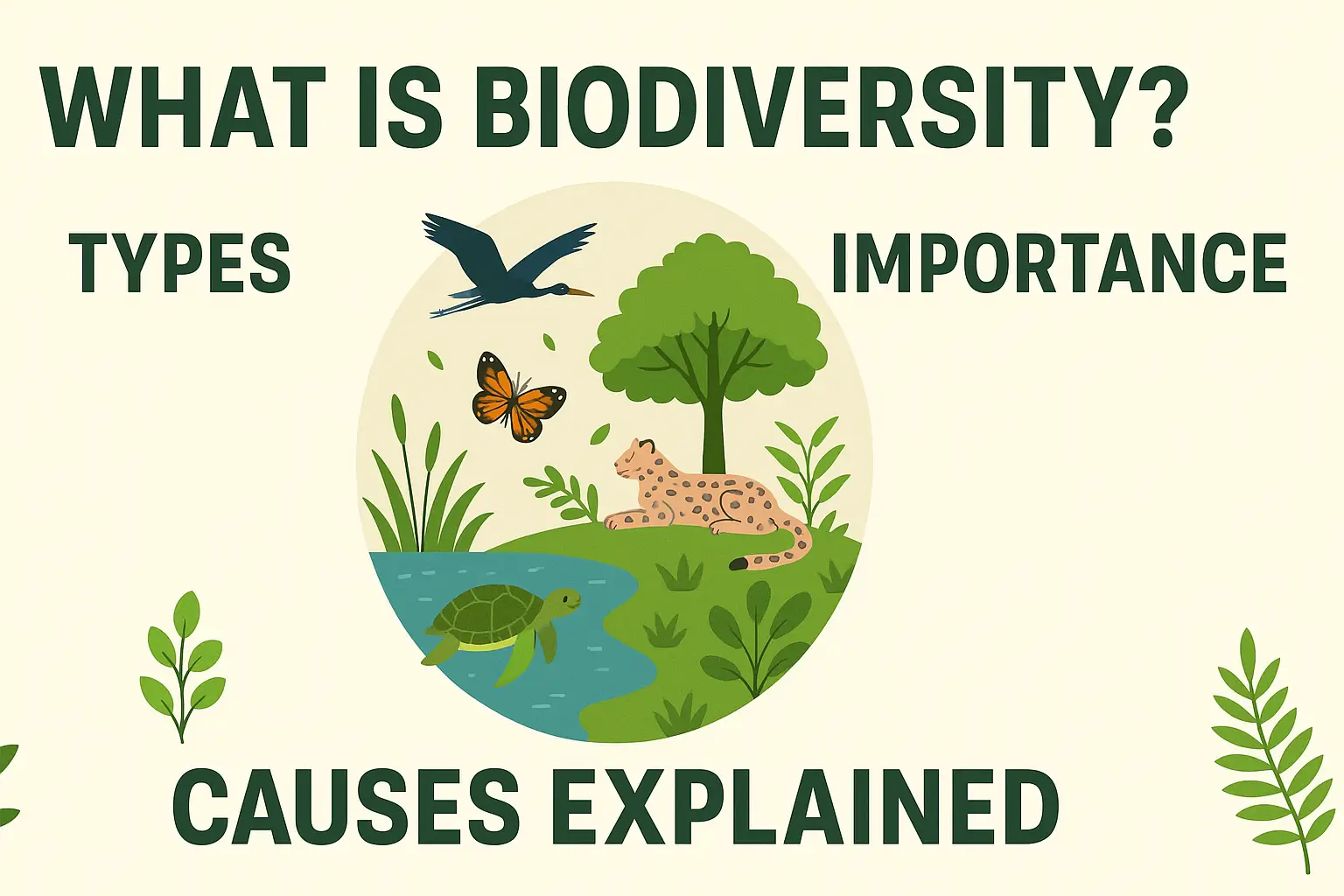What is Biodiversity? Types, Importance, and Causes

Biodiversity, also known as biological diversity, is one of the most vital aspects of life on Earth. It includes the wide variety of plants, animals, fungi, and microorganisms, the genetic differences within these species, and the ecosystems they form. Biodiversity supports everything in nature that humans rely on: food, water, medicine, climate regulation, and more. In this article, we will explore what biodiversity is, its types, importance, and the causes of its loss in detail.
What is Biodiversity?
The term “biodiversity” is a short form of biological diversity, referring to the variety and variability of life on Earth. It includes:
- Species Diversity: Different kinds of organisms.
- Genetic Diversity: Genetic variation within species.
- Ecosystem Diversity: The variety of habitats and ecosystems.
Biodiversity is found in every part of the world – from the cold Arctic tundra to tropical rainforests. It plays a critical role in maintaining the balance of nature and ensuring sustainability for all life forms, including humans.
Types of Biodiversity
Biodiversity can be categorized into three main types, each essential for life on Earth:
1. Genetic Diversity
This refers to the variation of genes within species. For example, every human being has unique genetic material. Similarly, rice or mango plants also have different varieties. Genetic diversity ensures that species can adapt to environmental changes and resist diseases.
2. Species Diversity
This includes the variety of species within a region or ecosystem. For instance, a tropical forest may have thousands of different species of trees, birds, insects, and mammals. Greater species diversity contributes to a more stable and productive ecosystem.
3. Ecosystem Diversity
This refers to the variety of ecosystems in a geographical area. Examples include forests, grasslands, deserts, wetlands, oceans, coral reefs, etc. Each ecosystem has its unique species and environmental conditions that support life.
Read Also: “What Is Plant Ecology? Key Concepts and Examples”
Importance of Biodiversity
Biodiversity is not just about the number of species—it’s about the relationships between them and their roles in the environment. Here’s why biodiversity is so important:
1. Ecological Stability
High biodiversity increases ecosystem productivity and resilience. Diverse ecosystems are better able to withstand environmental stresses, natural disasters, or human impacts.
2. Food Security
Different crops and animal breeds provide food variety. Genetic diversity helps in developing disease-resistant and high-yield varieties which are essential for feeding the growing global population.
3. Medicinal Resources
Many modern medicines are derived from plants and microorganisms. Biodiversity holds the potential for discovering new cures and treatments for diseases, including cancer and infections.
4. Economic Benefits
Forests, fisheries, and ecotourism industries depend on biodiversity. Millions of people globally earn their livelihoods directly or indirectly from biodiversity-related activities.
5. Climate Regulation
Forests and oceans act as carbon sinks, regulating the Earth’s climate by absorbing greenhouse gases. Wetlands purify water, and mangroves protect coastlines from storms and erosion.
6. Cultural and Spiritual Value
Many communities consider certain species or natural areas sacred. Biodiversity influences our cultural identity, traditions, and spiritual well-being.
Causes of Biodiversity Loss
Unfortunately, biodiversity is under severe threat due to human activities. Here are the major causes of biodiversity loss:
1. Habitat Destruction
The conversion of forests into farmland, urbanization, mining, and infrastructure development leads to the destruction of natural habitats, making it difficult for species to survive.
2. Pollution
Air, water, soil, and noise pollution harm both terrestrial and aquatic life. Pesticides, plastic waste, and industrial effluents damage ecosystems and kill species.
3. Overexploitation of Resources
Overfishing, hunting, poaching, logging, and excessive harvesting of medicinal plants reduce species populations and even lead to extinction.
4. Invasive Species
Introduction of non-native species in a region disrupts the natural balance, often leading to the decline or extinction of local species. For example, Lantana, an invasive plant, threatens native flora in India.
5. Climate Change
Global warming and climate change alter the natural habitats and migration patterns of species. Many species cannot adapt to these rapid changes and face extinction.
Read Also: What is Climate Change? Definition and Key Facts You Need to Know
6. Deforestation
Trees and forests play a key role in supporting biodiversity. Cutting down forests for agriculture or urban use destroys the homes of countless animals and plants.
7. Illegal Wildlife Trade
The illegal trade of endangered species, such as tigers, rhinos, and exotic birds, is a major threat to biodiversity, pushing many species toward extinction.
How to Protect Biodiversity
Protecting biodiversity is essential for the survival of life on Earth. Here are some strategies to conserve it:
1. Conservation of Natural Habitats
Protecting forests, wetlands, oceans, and other natural areas helps maintain ecosystems and the species that depend on them.
2. Afforestation and Reforestation
Planting new trees and restoring degraded forests can enhance biodiversity and prevent soil erosion and climate change effects.
3. Sustainable Use of Resources
Practicing eco-friendly farming, regulated fishing, and responsible tourism ensures that resources are used without harming nature.
4. Legal Protection and Policies
National and international laws like the Wildlife Protection Act, Forest Conservation Act, and Convention on Biological Diversity (CBD) help safeguard biodiversity.
5. Awareness and Education
Public awareness programs, school education, and community involvement are crucial in promoting the importance of biodiversity.
6. Research and Monitoring
Regular studies and biodiversity monitoring help in identifying endangered species and taking corrective action.
Biodiversity Hotspots in India (Example)
India is one of the 17 megadiverse countries of the world. It has four biodiversity hotspots:
- Himalayas
- Indo-Burma region
- Western Ghats and Sri Lanka
- Sundaland (Nicobar Islands)
These hotspots are rich in endemic and threatened species, and urgent conservation efforts are needed to protect them.
Conclusion
Biodiversity is the foundation of life on Earth. From providing essential services like food, medicine, and clean air to maintaining ecological balance, its value is immeasurable. However, human activities have led to its rapid decline. Understanding biodiversity, its types, importance, and the causes of its loss is the first step towards protecting it. Through collective efforts, sustainable practices, and responsible governance, we can conserve biodiversity for future generations.







3 thoughts on “What is Biodiversity? Types, Importance, and Causes”